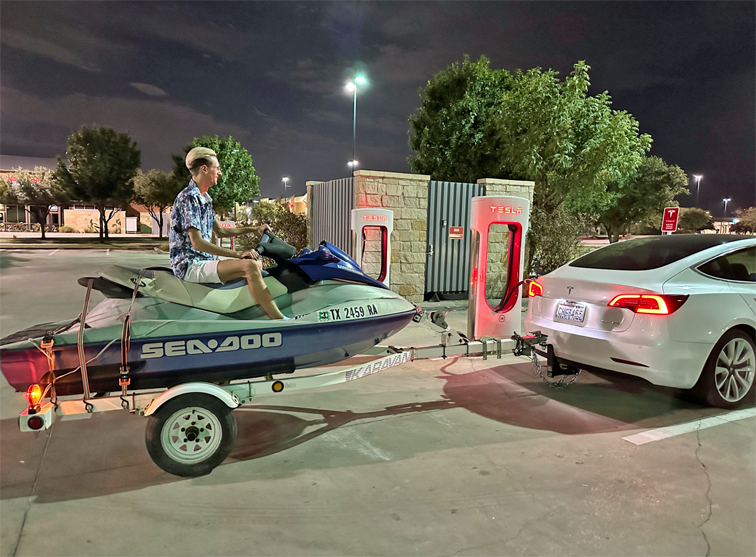‘Jet Skiing’ Across the Country in a Tesla
Empowered Tesla drivers are taking ambitious road trips — including jet ski towing — due to the automaker's Supercharger Network.

Tesla achieved the 50,000 supercharger milestone in early September and has been building fast charging stations since 2012. Put simply, Tesla drivers enjoy long distance electric vehicle driving due to dependable and fast charging stops. fast.
However, what about towing a jet ski in a Model 3?
Jabob Probstfield and a friend recently revealed this on X (formerly known as Twitter). The road trip mission in a 2019 Model 3 long-range was to travel from Tacoma, WA to Dallas, TX, pick up a jet ski and the return home all in quick fashion.

Jet Ski Road Trip in a Tesla Model 3
The reason for this road trip was to pick up a Sea-Doo Jet Ski.
Two drivers, Jacob & B.
Drove nonstop from Tacoma to Dallas. No stops to sleep;
When Jacob was driving “B” was trying to sleep & vice versa.
Completed in a 2019 Model 3 LR AWD with aftermarket hitch
According to the post, Jacob picked up an aftermarket hitch for his 2019 Model 3 LR AWD (PEEV reached out about the brand). The trip from Tacoma to Dallas was 2,071 miles and used 614 kWH at an efficiency average of 296 Wh/mi. “We stayed 10% above the posted speed limit for the majority of this leg,” according to Probstfield.
So Probstfield’s Model 3 made it to Dallas in two days — without hotel stays — and they stayed in town for approximately 23 hours and then towed the Sea-Doo back to Tacoma. “We were pleasantly surprised at how easily a Model 3 can tow a jet ski, it felt like nothing was behind us, and we had plenty of power. Yes, it affected efficiency but it wasn’t extreme,” says Probstfield.
No More Range Anxiety
Tesla road trips don’t scare owners. Supercharging stations appear about every 100 miles on major interstates — see image below. Going forward, this may even apply to Ford F150s, GM’s Equinox (2024), and other non-Tesla autos. Tesla has announced multiple agreements with other automakers to share their network going forward, including Ford, Honda, GM and others.
According to a Reuters article on this topic, “Tesla’s supercharger network already accounts for 60% of U.S. and Canadian fast chargers. GM and Ford’s customers will now have access to the most widely deployed infrastructure. The partnership will also likely kill off competing standards - Tesla, Ford and GM accounted for three-quarters of electric cars sold in 2022, according to Experian.
Back to the SeaDoo EV Road Trip
Once Probstfield hitched the Sea-Doo, the road trippers made it back to Tacoma in two days. Below are the efficiency stats on the way back with the Sea-Doo
Dallas to Tacoma Efficiency:
2,246 miles
965 kWh
429 Wh/mi
Probstfield posted that “speed on this leg was mostly at or 10% below posted speed limits.” The journey was 4,378 miles, and the total energy used was 1,598 kWH with an average of 365 Wh/mi. 365 Wh/mil is high for highway driving, but not for towing.
The Model 3 also handled most of the driving via FSD beta: “98% of the total driving,” according to Probstfield. “This trip was made possible by the Tesla Supercharger Network. We had 100% perfect charge sessions, and 0 stalls were out of order,” says Probstfield. “I had expected maybe one or two issues, but no, ZERO issues with the car or the charging network.”
Plugged In EVs - Have you ever towed in either a Model 3, Y or Model S? What has your experience been like?





